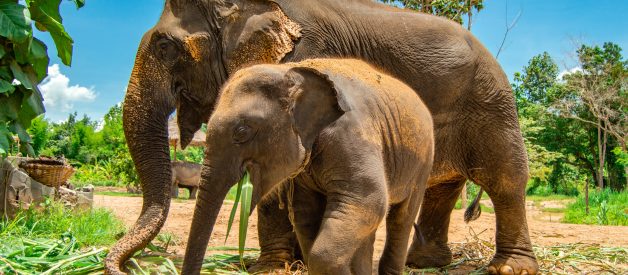Last updated 17th of February, 2019.
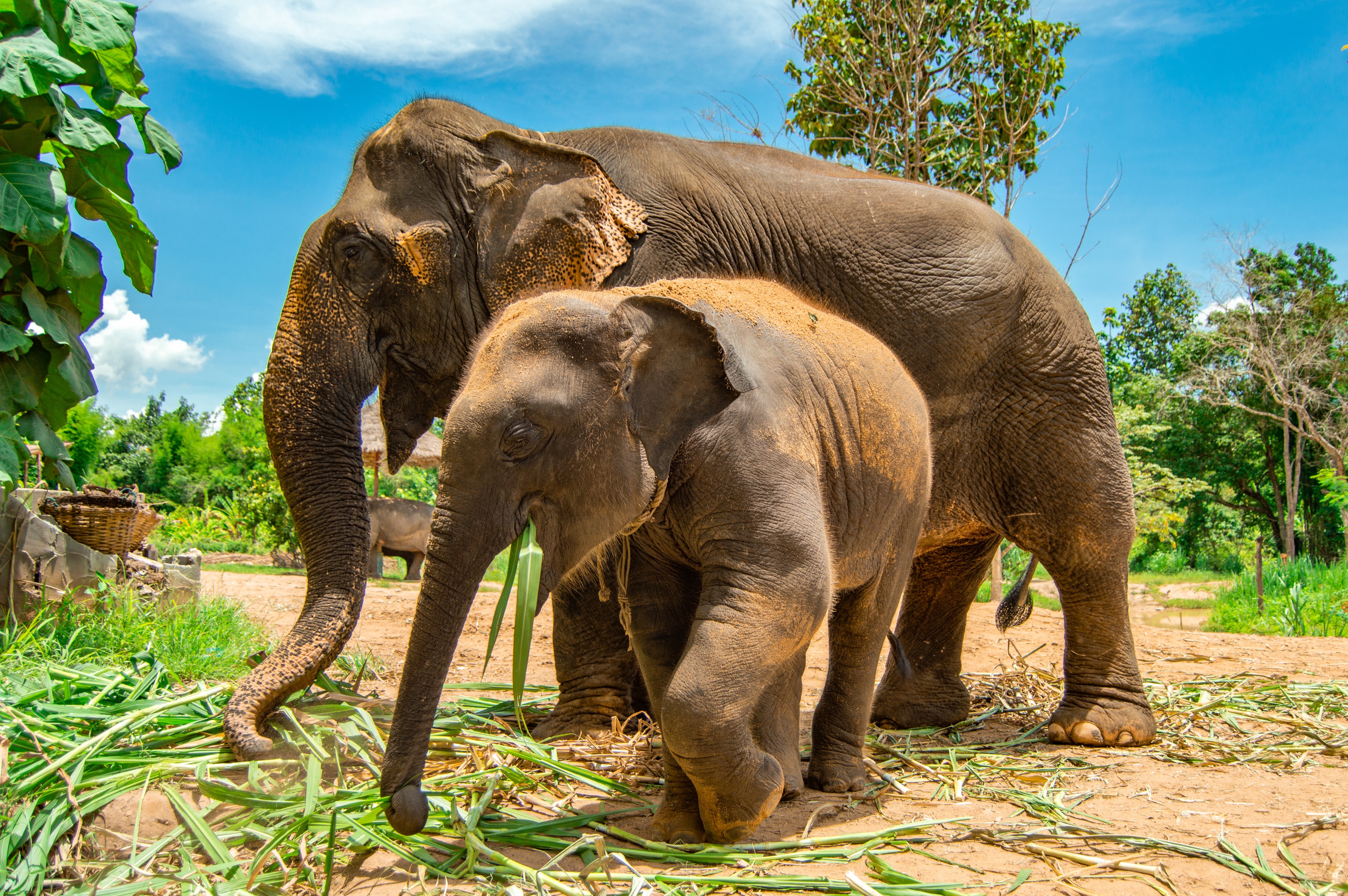 A 40 year old female Sri Lankan elephant eats grass with a 2 year old Indian elephant. There are 4 recognized subspecies of Asian elephants; Indian (from the mainland), Sri Lankan, and two Indonesian (from the islands of Sumatra and Borneo). Asian Elephants cannot mate with African elephants as they are of a different genera. Photo Credit: Aydin Adnan
A 40 year old female Sri Lankan elephant eats grass with a 2 year old Indian elephant. There are 4 recognized subspecies of Asian elephants; Indian (from the mainland), Sri Lankan, and two Indonesian (from the islands of Sumatra and Borneo). Asian Elephants cannot mate with African elephants as they are of a different genera. Photo Credit: Aydin Adnan
Can you recall the very first time you saw an elephant? For most people this initial interaction is at a zoo, or a safari park in which the elephant is far removed from its natural habitat and confined in a small area. As children, we don?t know any better so we marvel at the massive size and beauty of the world?s largest land mammal. What we don?t see is the price the elephant had to pay, the torture endured, and the crippling feeling of depression it suffers for us to be able enjoy our time at the zoo or safari. If you aren?t already aware of the abuse elephants have to endure to be tamed, then head over to Wildlife Friends Foundation Thailand?s website for a great factoid sheet.
Before I go further into telling you why you shouldn?t go to a sanctuary, I feel it is important for you to know who I am, and why I?m acting as an authority on the matter. I?m a 30 year old expatriate from a small suburb of Washington, DC. Like most expatriates, I grew tired of the ?career grind? and the false dreams sold to us as children. I left in search of something more meaningful. I didn?t know where I would end up (and I still don?t) but I knew one thing: I wanted to go to Thailand and work with elephants. I had been dreaming of doing any type of conservation work for elephants since I was a child.
I began my research online seeking opportunities to volunteer in conservation and/or rehabilitation projects. Most results turned up Non-Governmental Organizations (NGO) who either weren?t accepting new volunteers, required a commitment time of a year or longer, or simply required higher qualifications than I had. So, I turned to sanctuaries, which are littered throughout northern Thailand, primarily around the touristic city of Chiang Mai. Almost every sanctuary I came across required a volunteering fee which would ?cover accommodations, meals, and would be used to fund the sanctuary.? To me, the idea of paying to volunteer is like saying ?I?ll pay you to work for you? and is something I refuse to do. I became disheartened that I would not have the opportunity to work with elephants.
Through a stroke of luck, a good friend of mine, Jay, just returned from Chiang Mai and visited a sanctuary in dire need of volunteers. This was a smaller, newer sanctuary, and could use all the help so there were no volunteering fees. I contacted the sanctuary and some months later I arrived as a volunteer who had committed to 1 month of work.
Volunteering
Although I wasn?t expecting to do groundbreaking conservation work, I was expecting to do something for the benefit of the elephants. I learned within the first few days that I would be doing no such thing. My role was just to be an English speaking tour guide for the tourists who came to interact with the elephants.
The tour schedule consisted of the customers arriving and feeding the elephants a handful of bananas to ?say hello.? We then gave them a change of clothes and had them watch an introduction video which gave information about elephant exploitation as well as the sanctuary. Then, I would step in to give a formal introduction as well as facts about our elephants such as name, age, personality, and most importantly, where they were rescued from. The tour would commence with feeding more bananas in the enclosure. We encouraged the customers to pet them, hug their trunks, grab some skin to feel the thickness, and even grab their tails to feel the bristle. The tour moved on to taking the elephants on a walk ?through the jungle,? which really was just a village road with thick trees on either side. The walk would end at a small open field where the elephants would roam and be fed mangoes from the trees nearby or grass that was carried from camp.
Close to an hour and half later, depending on the pace of the tour and how many tourists we had, we would walk the elephants back to the sanctuary through a small river that had all of its water diverted out. This was done to increase the feeling of being in a jungle as you couldn?t see the surrounding farms from the river. The river was connected directly to the sanctuary and the walk would end at a mud pit. Here, we encouraged the tourists to rub the mud onto the skin of not only the elephants but each other as well. Once everyone and the elephants were thoroughly mudded, we moved over to a larger man-made lake to rinse off. The tour would then end with a shower and Thai noodle soup.
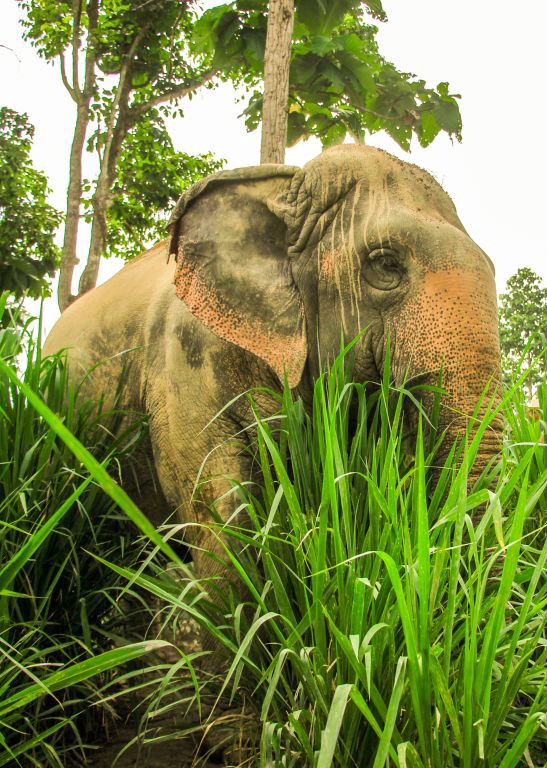 One of SMR?s elephants heading toward the river through very tall grass. The grass gives the impression of being in a jungle as seen in the photo. Photo Credit: Aydin Adnan
One of SMR?s elephants heading toward the river through very tall grass. The grass gives the impression of being in a jungle as seen in the photo. Photo Credit: Aydin Adnan
After 2 weeks, I found I could no longer continue to volunteer, for a multitude of reasons which I will cover, and cut my commitment down to just 3 weeks. I?ll refrain from mentioning the name of the sanctuary I volunteered at because I don?t intend on critiquing them in particular but rather highlight issues concerning the sanctuary model. I will instead refer to this sanctuary as Sanctuary MR or SMR for short.
I would like to mention that although I found myself unable to work at SMR any longer, I was very happy during my time there due to the people. The sanctuary provides employment for around 20 locals, and each member of staff was so kind. I became really good friends with the tour guides, we would eat and go out drinking together. Knowing that I am a photographer, the sanctuary photographers would occasionally allow me to take pictures when they were short staffed. I honestly think each member of staff believes they are doing good for the elephants by removing them from their abusive owners. But sometimes, even with the best of intentions, we don?t realize what we?re doing is wrong.
Marketing
 A 17th century Indian Elephant goad housed at Walters Art Museum in Baltimore, Maryland. Modern day equivalents have a wooden handle and an iron hook without a taper or a broad point. Photo Credit: Walters Art Museum
A 17th century Indian Elephant goad housed at Walters Art Museum in Baltimore, Maryland. Modern day equivalents have a wooden handle and an iron hook without a taper or a broad point. Photo Credit: Walters Art Museum
Through clever marketing, one can sell a pair of eyeglasses to a blind man. The same is true of the sanctuaries that market themselves as ethical, sustainable, and abuse free. Walk anywhere in Chiang Mai and you will see advertisements for various sanctuaries marketing themselves free of elephant riding or use of hooks (also known as the elephant goad, a very sharp hook with a tapered end used to abuse the elephant into submission). By highlighting the cruelty an elephant faces in riding, logging, or circus camps, these sanctuaries brand themselves as the better alternative. They also market themselves as having ?rescued? the animal from harsh conditions when in reality they have either rented or bought them from the owner to operate their business. A tourist could be forgiven for believing that they are ?doing the right thing? by visiting a sanctuary instead of a circus. Though I must contest that it is far better for an elephant to be at a sanctuary than any of the aforementioned camps, at the end of the day captivity is captivity.
Profits
As mentioned, this sanctuary is one of the newer ones. It was founded by a local Thai woman less than two years ago. Within such short amount of time, the sanctuary has grown rapidly. When I first arrived we had five elephants (of which I only interacted with four; in fact I have not even seen the 5th), and by the time I left, two more had been purchased. The average cost of an elephant, depending on age, health, and tame-ability, ranges anywhere between $40,000-$80,000 USD. If we assume that all the elephants were in the median of $60,000 then that?s a total of $420,000 in value!
The assets of the sanctuary don?t just end at the elephants. They also own the land on which the sanctuary is established. SMR owns about 5 acres of land near a small village north of Chiang Mai. I asked one of the managers roughly how much 1 acre costs and was told close to $50,000; multiply that by the 5 acres owned and you have total land assets of $250,000. According to the World Bank, Thailand?s Gross National Income for year 2017 for the upper middle class is $5,960. I only mention this to give you a reference point to how much money sanctuaries earn in comparison.
There was a culture at the sanctuary of telling the tourists that we operate as a non profit organization, but this was far from the truth. At the end of our introduction speech, we would point to a poster of a poor elephant in a riding camp asking for donations to bring this elephant here. In reality we had more than enough money for this elephant, it just wasn?t done with its contract with the riding camp. I only found out after 2 other elephants were brought to the camp before this one. Through my ignorance, I was guilty of telling the customers that all donations go towards rescuing this particular elephant and this is why we need their help.
SMR had 3 tours per day, 2 half day tours and 1 full day tour. The half day tours were priced at 1500 baht, and the full day at 2000 baht. On average, there were about 10 people in each group (this number is just used for calculation purposes as at times we had 2 people in a group, whereas at others we had 26). If 20 visit the 2 half day tours, and 10 visit the full day, the sanctuary has earned revenue of 50,000 baht. The tour guides were paid 600 baht for half day, and 900 for full day; subtract that from the revenue earned and the sanctuary has earned 47,900 for the day. As the sanctuary operates 7 days a week (except national holidays) we can assume that at this rate they have earned give or take close to 16.2 million baht, or $490,000 USD per year. Since SMR operates as private business, I didn?t have access to their accounting records so I?m not able to equate what their profit margin is after expenses and wages, but given the fact that they were able to purchase 5 acres and 7 elephants in such a short time, alludes to high profits. I would like to add that this sanctuary is a sole proprietorship, and all the profits went to the owner.
 An elephant rests its trunk on the ground, this indicates that they have fallen asleep. Unlike humans, elephants sleep standing in 30 seconds to a few minutes intervals. In total, throughout the day, an elephant will sleep around four hours; the rest of the time is spent roaming for food and water. Photo Credit: Aydin Adnan
An elephant rests its trunk on the ground, this indicates that they have fallen asleep. Unlike humans, elephants sleep standing in 30 seconds to a few minutes intervals. In total, throughout the day, an elephant will sleep around four hours; the rest of the time is spent roaming for food and water. Photo Credit: Aydin Adnan
Sustainability
The elephant sanctuary model relies very heavily on a valuable asset; elephants. Namely elephants that have been captured, tamed, and used in the tourism industry either in the circus or in elephant riding camps. These elephants have spent years being around humans, are very docile, and aren?t bothered by tourists petting them, hugging their trunks, or grabbing their tails. Many sanctuaries will not purchase elephants that are not tame, easy to control, or injured. If there are no tamed elephants, then there will no longer be any sanctuaries, so the very organizations that claim to exist for their benefit, merely exist to exploit them for financial gains.
Rehabilitation
There are some elephants who are not so tame, these primarily come from logging camps where the power of the elephant is used to move large pieces of timber up and down tall hills and mountains. Most of these elephants are kept in chains throughout the entire day, and constantly whipped, poked, or prodded with the hook to keep it working. The only interactions these elephants have with humans is primarily through abuse and are not well suited for interaction with tourists. Through retraining, such an elephant can be tamed to change its behavior and SMR had an elephant from a riding camp. Every so often, when she was feeling anxious or uncomfortable, she would lash out by using her trunk to push back anyone who was near her, and in fact she did this to me on two different occasions. The mahouts (Thai for elephant keeper) in charge of her did not like it when she did this as it is not good for the image of the sanctuary. Though I didn?t personally see the repercussions, I?m certain that she was punished for it after we left. My suspicions were confirmed through conversations with some of the tour guides; ?you have to understand, when an animal misbehaves, you have to punish it otherwise it will continue that behavior. If your dog pees on the carpet, you won?t just leave him will you?? So it seems the only rehabilitation at sanctuaries revolves around ensuring that the elephants are calm and tame around the tourists who come to visit them.
Abuse
Although the elephant goad is not used at the sanctuaries, the abuse doesn?t quite end. The main issue is that the mahouts who have been hired by the sanctuaries to watch over the elephants are the very same ones that have abused elephants in the past. Being a mahout is a family business, you?re born into it, around elephants from the time you can walk, and taught how to tame them as well. So abusing the elephant in an effort to get it to do what you want is something that has been ingrained into the mahouts.
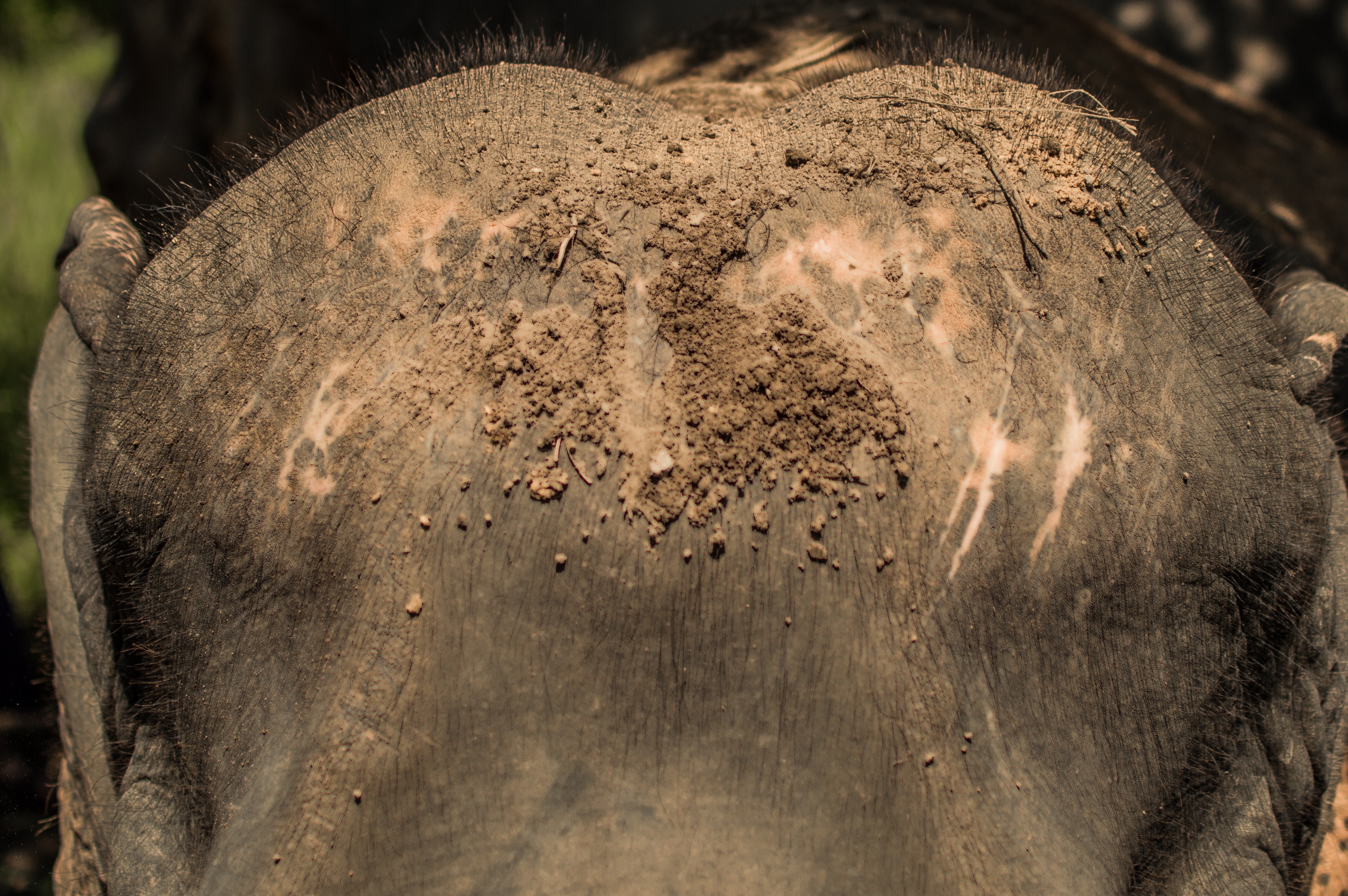 All of the adult elephants bear the scars of Phajaan, or Crushing, which is the process of breaking the spirit to bend to the will of humans. Photo Credit: Aydin Adnan
All of the adult elephants bear the scars of Phajaan, or Crushing, which is the process of breaking the spirit to bend to the will of humans. Photo Credit: Aydin Adnan
During my time at SMR, I unfortunately became witness to abuse on a few occasions. In one such occasion, I noticed a mahout holding a very small object in his left hand. He kept his fingers curled to conceal what he was holding, and would consistently put the object into his pocket out of sight. I watched him vigilantly in an effort to identify the object and its purpose. I saw him use the object and press into the elephants side when she refused to move, and then immediately holster it back into his pocket. On the same day, not 20 minutes later, I saw another mahout do the exact same thing, only this time he did it with such ferocity, that the elephant let out a trumpeted shout. The sound coming from her made my heart sink to the deepest depths of the ocean. The mahout didn?t know I was looking, and when he turned around and saw me, he gave a great big smile and exclaimed ?[the noise] means shes happy!? But I was not to be fooled, I forced myself to smile back and resumed my effort to identify the object. Alas, I was unable to do so because the mahouts were adept at concealment. I reported what I saw to the sanctuary manager who said she would have a talk with the mahouts, and that they were newer and probably didn?t know not to do this (though I doubt that they didn?t know). The day after my report, I noticed the mahouts keeping their distance from me, and I did not see any other abuse after. I?m not sure if this is because they were very careful around my presence, or if they actually rehabilitated themselves and stopped the abuse; I hope for the latter.
Mahouts
As mentioned before, the mahouts are elephant handlers who ensure the elephants stay on course for the duration of the tour and do not harm any of the tourists. At the sanctuary, we would tell the tourists that the mahouts had a ?special bond? with the elephants, which is why they were so responsive to the mahout?s commands. Each elephant had its own dedicated mahout by its side. We would also say that when a new mahout first arrives, they would spend a month or more with their assigned elephant building that bond. In my ignorance I believed this to be true, but reality is much more sinister.
The time the mahout would spend getting to ?know? the elephant and build a ?bond? was centered around abuse. The mahout would systematically abuse the elephant so that it would understand that he is the new master and his commands should be obeyed. So during a tour, when a mahout calls out ?pai pai pai,? ?go, go, go? or ?ma, ma, ma,? ?come, come, come,? the elephant would understand this as a command and respond ?or else.? Although I?m not sure what tools or methods were used, a conversation with one of my tour guides confirmed that the ?special bonding time? was not what we told the tourists.
Freedom
At the sanctuary we like to say we rescued and freed the elephants in our care, as a matter of fact, one of them was even named Freedom. The truth of the matter is that they are no more free in a sanctuary, than they were in their previous camp. In the wild, elephants roam around the forests and jungles near 20 kilometers a day in search of food and water. This keeps them moving and the exercise keeps them healthy and lean. In captivity, they are not able to maintain the same level of activity which leads to obesity, joint pains, and depression. Elephants in the wild live on average close to 70 years, but in captivity, this can be reduced by up to half!
The pressing concern I have regarding captivity is where the elephants are kept at night. Visit any sanctuary and there will be an area for the tourists, and an off limits area for staff only. Though I was part of staff, if only as a volunteer, I never laid eyes on the area where the elephants were kept at night. When asked about where they are kept, I received conflicting answers from management. I turned to my tour guide friends for more insight. One out right told me that they were kept tied up at night, another alluded to it without using the words, and a third tried to explain the reasoning. ?If you have a dog back home, you?re not just going to let it roam around your neighborhood all night right? If he goes onto your neighbor?s yard and takes a shit, then that?s going to create problems. You keep your dog in your house or in your backyard where you have a fence so you can keep an eye on him.? I found it interesting that the analogy of the common household pet was used once again for these very large wild, intelligent, and emotional beings.
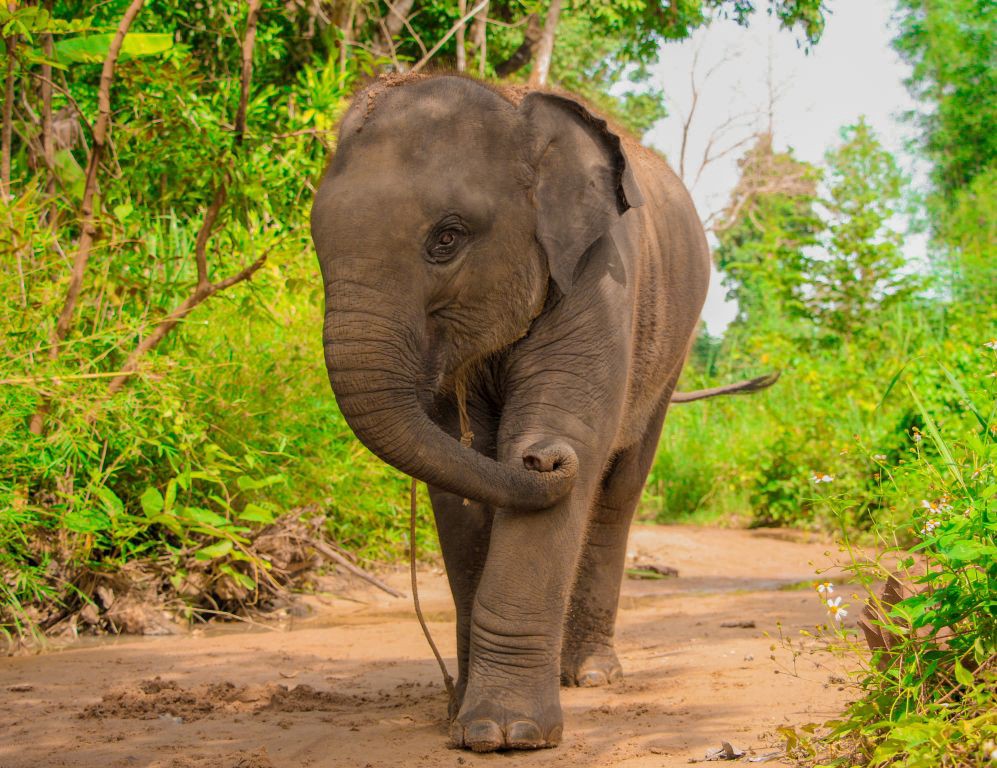 The only baby elephant at SMR, aged 2 and half years, walking through the dried out river. He would constantly tug at the rope around his neck in an effort to undo and/or remove it. Tourists were told were told that the ropes help to guide the elephants, but I fear they were used to tie them up at night. Photo Credit: Aydin Adnan
The only baby elephant at SMR, aged 2 and half years, walking through the dried out river. He would constantly tug at the rope around his neck in an effort to undo and/or remove it. Tourists were told were told that the ropes help to guide the elephants, but I fear they were used to tie them up at night. Photo Credit: Aydin Adnan
The only real freedom for elephants is back in the forest amongst the trees where they can live their lives in peace without any interaction from humans; positive or negative. I was given no training before beginning my volunteership, I was thrown to the wolves (or elephants in this case) and left to learn on my own. I resolved to listen to everything the tour guides said and to memorize it. One of the questions that was consistently asked was ?will these elephants ever be released back into the wild?? All 3 of the tour guides would use different words but effectively say no, they cannot be released. One would say that they have lost the ability to survive in the wild because humans have broken them, another would say they are dependent on us now to feed them, and the last would say that if released, the elephants would come onto human farms and plantations to feed which would anger the local villagers who would then retaliate, or capture them once more. In my ignorance and the belief that most humans don?t lie, I believed what the tour guides said and began to repeat these reasons myself.
Once I began to question everything I had learned at the sanctuary, I decided to research on my own. It took one search on Google to find a study regarding the reintroduction of captive Asian elephants into the jungles of Thailand from a reputable organization. The American Museum of Natural History conducted a 2 year study in which they monitored, through a GPS linked collar, 7 rehabilitated Asian elephants released back into the wild. Through the study the researchers confidently reported that the elephants had regressed to their wild behavior, had no difficulty finding food or water, and moved further into the jungle away from humans. Once I knew this, I found myself unable to work at the sanctuary any longer.
So why don?t elephants in sanctuaries get released back into the wild? Well, when you pay anywhere between $40,000-$80,000 USD for an elephant, you do so as an investment, one which requires high return. You don?t just release such an expensive asset into the wild to be free. You keep it at the sanctuary so tourists can come see the elephant, feed it, pet it, bathe it, and take many many selfies with it. You charge the tourists a lot of money to do so, and tell them that the elephants were rescued from even more deprave conditions so that they will accept the sanctuary as a ?nice home? for the elephants. Such is the elephant sanctuary model, and this is exactly why it is not sustainable nor beneficial for the elephants.
Reserves
It is said that if you love and appreciate the beauty of a flower, you would not pick it, for doing so is to kill it. The same can be said of elephants, if you truly love elephants, then you will not want to see them in any form of captivity. I understand the desire to see elephants or even be near them, it?s what drove me to come to Thailand. But the only true way to see elephants is to visit a reserve. There are 2 very large national parks in Thailand which have been declared wildlife reserves. In central Thailand you have Khao Yai park, and in the south, Kui Buri park. Both contain a population of wild elephants who have never interacted with humans. At the parks you can view elephants in their natural habitat from a distance. Sure you can?t go up to them, touch them, or bathe them, but then that?s the point; to do any of that requires removing the elephant from the wild and taming it. There are even camping facilities at Kui Buri if you wanted to spend some time watching their behavior and not just get a glimpse of them.
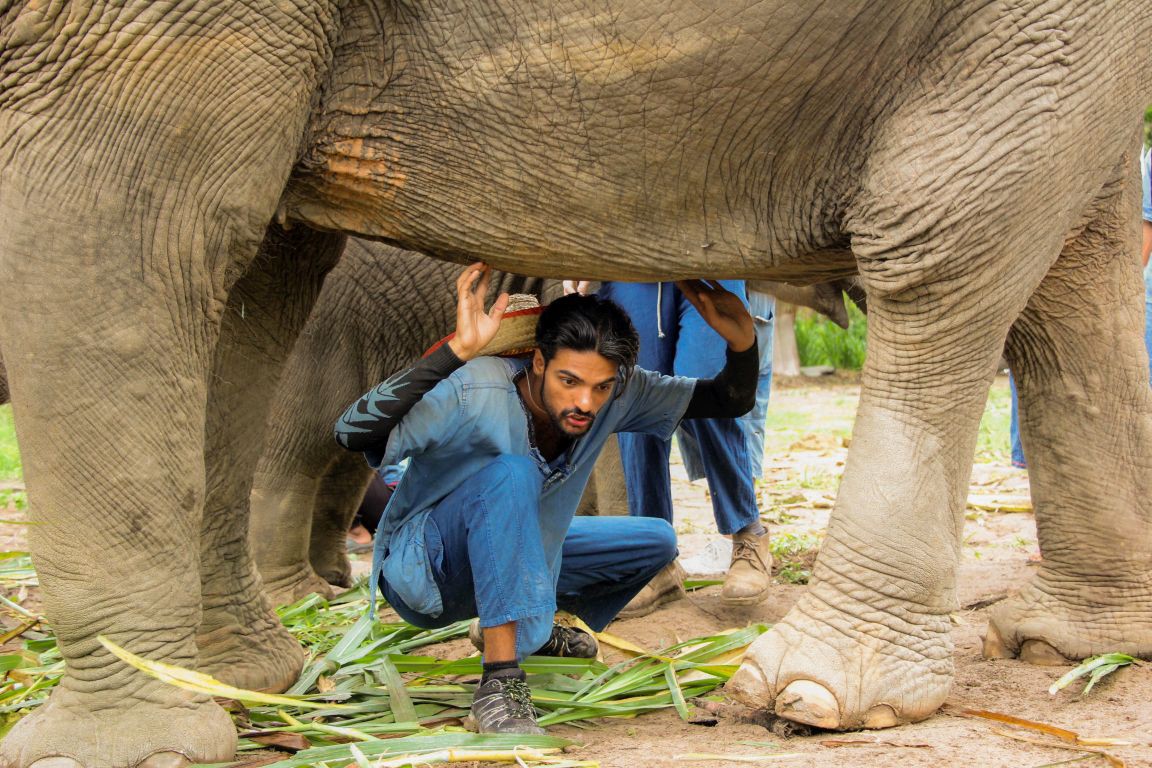 In Thai culture, it is considered good luck to crawl under an elephant. As a tour guide, I would invite willing tourists to follow my lead. I often find myself regretting this as I?m sure it made the elephants uncomfortable. Photo Credit: SMR
In Thai culture, it is considered good luck to crawl under an elephant. As a tour guide, I would invite willing tourists to follow my lead. I often find myself regretting this as I?m sure it made the elephants uncomfortable. Photo Credit: SMR
Just 4 years ago, a visit to Chiang Mai yielded many offers to visit an elephant circus or ride on an elephant. Once the campaign to shed light on the cruelty entertainment elephants have to endure began, more tourists began to reject such attractions. Now you will be hard pressed to find an elephant riding camp in Chiang Mai, they are virtually non-existent. Elephant owners began to notice this shift and then opened up sanctuaries, or rented their elephants to sanctuaries, in an effort to replace the income lost by a decline in riding. The power we carry in our wallets is astounding! If tourists spend more money on riding, there will be more riding camps. If they spend on sanctuaries, there will be more of them. But if the money is spent on national parks, then perhaps more and more of these captive elephants may end up there. If the elephant owners no longer have a way to generate income through them via a camp or sanctuary, then perhaps they will cut their losses and sell the animal to a national park. I understand that this is merely conjecture, but if you follow the trends, and make significant changes, I believe it is entirely possible. The decision lies with you, the tourist.
Addendum
I first wrote this article in July of 2018, since then I had the opportunity to revisit Chiang Mai. Walking around town I saw many advertisements for SMR, so much more than when I was first there. I see fliers, pamphlets, posters, stickers, and banners on the side of taxis. It seems to me like SMR is now one of the top 3 sanctuaries in Chiang Mai which deeply saddens me.
It took me quite a few days to gather up the courage to go and see my tour guide friends because I knew they had read my article and I wasn?t sure if they appreciated me quoting them or even my views. When I finally did approach them, they welcomed me with open arms. We eventually talked about the article and to my surprise they agreed that everything I had written was true and that they could not deny it. They confirmed that business was booming! More elephants were purchased, the tour group sizes had doubled, and plans were in motion to expand. They also confided in me how overworked, underpaid, and undervalued they felt. They expressed their desire to leave the sanctuary and start a business venture unrelated to elephants.
Change is slow, and progress even slower. At the hostels I stay, I see so many excited tourists talking about their adventure. I hope a movement, one bigger than my humble article, dedicated to ending cruelty towards animals, not just elephants, will wash over Thailand and indeed the rest of the world. I hope one day we humans can stop seeing the animals that we share this earth with as a means to an end. I hope one day we can truly accept that this planet is not our own and that the wildlife here has every right to live in peace.
